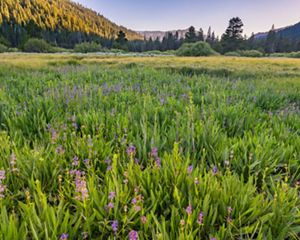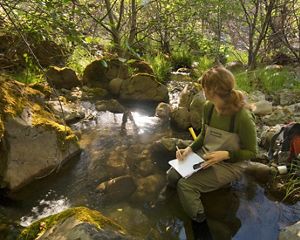Purchase of Property in Proctor Valley to Ensure Preservation of Essential Biodiversity and Wildlife

Media Contacts
-
Armin Mahramzadeh
The Nature Conservancy
Email: a.mahramzadeh@tnc.org -
Mark Topping
Wildlife Conservation Board
Email: Mark.Topping@wildlife.ca.gov
The nearly 1,300-acre property in Southern California is home to threatened and endangered species and rare and highly biodiverse habitat types, making this purchase a significant victory for conservation.


The Nature Conservancy (TNC), California Department of Fish and Wildlife (CDFW), California Wildlife Conservation Board (WCB) and United States Fish and Wildlife Service (USFWS) have collaborated to complete the acquisition of approximately 1,291 acres of property in Proctor Valley in southwestern San Diego County, an area adjacent to CDFW’s Rancho Jamul Ecological Reserve and USFWS’s San Diego National Wildlife Refuge. As this property sits at the heart of more than 60,000 protected acres, its acquisition now successfully links and connects the reserve-refuge conservation area, saving it from potential development and habitat fragmentation. The property will be owned and managed by CDFW as an expansion of the Rancho Jamul Ecological Reserve.
“Wildlife connectivity is a top priority of the state, and it’s encouraging to see years of work finally come to fruition,” said Charlton H. Bonham, director of CDFW. “Today’s closing shows the greatest value of this property is connecting the San Diego National Wildlife Refuge to the Rancho Jamul Ecological Reserve and the Otay Mountain Wilderness Area. Wildlife that uses this land will now have much more room to roam.”
“It is hard to overstate the importance of this transaction,” said Scott Morrison, director of conservation and science for TNC in California. “Protecting this property fortifies the very cornerstone of southern California’s regional conservation planning efforts. Its protection enhances the resiliency of countless conservation investments made by the public in this region over the decades. What an inspiring testament to the power of partnership and commitment. It’s an achievement of the whole of San Diego’s incredible conservation community.”
Nearly 70% of the property was targeted for development, which would have fragmented the rare and highly biodiverse coastal sage scrub preserve and led to the loss of core habitat for numerous rare and endemic species, like the Quino checkerspot butterfly and the San Diego fairy shrimp, and essential foraging habitat for the coastal California gnatcatcher and golden eagle, if the development had occurred.
"The conservation of this land is a significant step forward for our vision of establishing a set of connected, managed lands across Southern California," said Paul Souza, Pacific Southwest regional director of the USFWS. “This achievement was made possible through our strong, enduring partnerships with federal, state and local organizations, and we want to recognize their hard work to get this acquisition across the finish line.”
TNC, CDFW, WCB, USFWS and numerous other public and private conservation partners have prioritized for protection properties needed to establish a network of core area reserves and habitat linkages essential to preserving biodiversity and enhancing resiliency in the face of global climate change. Much of this conservation is due to the foundational San Diego County Multiple Species Conservation Plan (MSCP), adopted in 1997 by the County of San Diego. This plan was created as one of the earliest state-approved Natural Communities Conservation Plans (NCCP) and the federally approved Habitat Conservation Plan (HCP).
Following negotiations and TNC securing an agreement with the landowner to acquire the property for conservation, WCB approved $30 million for the purchase.
“WCB is proud to carry out this major conservation victory and permanent protection of important biological, scenic and cultural resources for the people of California,” said Jennifer Norris, WCB executive director. “I am thankful for our staff at WCB and our partners at TNC and USFWS for facilitating this complex transaction that provides for permanent protection of rare and endangered species such as the Quino checkerspot butterfly.”
Quote: Mike Sweeney
The partnerships and public and private funding brought to this acquisition are notable. The State of California, in particular, WCB and CDFW, and our federal partners at the USFWS have shown up in a significant way through their investment of funds and commitment of staff.
Other funding for the property comes from TNC through private donors, USFWS and the Department of Homeland Security (DHS). The $25 million from DHS came to the State of California for the purchase of the property from a settlement agreement over the construction of the U.S.-Mexico border wall.
“The partnerships and public and private funding brought to this acquisition are notable,” said Mike Sweeney, executive director of the California Chapter of TNC. “The State of California, in particular, WCB and CDFW, and our federal partners at the USFWS have shown up in a significant way through their investment of funds and commitment of staff. TNC celebrates what we have all achieved today.”
The reserve-refuge conservation area, which now includes the Proctor Valley property, has been a focus of significant conservation investment over the last three decades and is one of the most important target areas in California, as it contains numerous endangered and threatened species that depend on substantial conserved private and public landholdings for survival. This purchase bolsters land protection in, and reduces threats to, this landscape and continues to build out the core area preserve and to protect habitat connectivity so animals can move and adapt as they live in and move through the reserve-refuge conservation area.
The Nature Conservancy is a global conservation organization dedicated to conserving the lands and waters on which all life depends. Guided by science, we create innovative, on-the-ground solutions to our world’s toughest challenges so that nature and people can thrive together. We are tackling climate change, conserving lands, waters and oceans at an unprecedented scale, providing food and water sustainably and helping make cities more resilient. The Nature Conservancy is working to make a lasting difference around the world in 83 countries and territories (39 by direct conservation impact and 44 through partners) through a collaborative approach that engages local communities, governments, the private sector, and other partners. For more news, visit our newsroom or follow The Nature Conservancy on LinkedIn.
About California Department of Fish and Wildlife
CDFW's mission is to manage California's diverse fish, wildlife, and plant resources, and the habitats upon which they depend, for their ecological values and for their use and enjoyment by the public.
About California Wildlife Conservation Board
The WCB was founded in 1947 for the purpose of conserving California’s wildlife and providing wildlife-oriented recreation. WCB is also responsible for implementing a variety of legislative and voter-approved conservation programs statewide designed to protect wildlife areas, address climate change, and protect the desert, ensuring all Californians have access to nature.
About United States Fish and Wildlife Service
The mission of the USFWS is to work with others to conserve, protect, and enhance fish, wildlife, and plants and their habitats for the continuing benefit of the American people.


